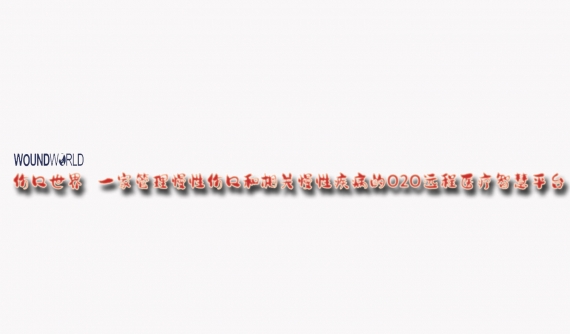1. Introduction
Diabetes Mellitus (DM) and chronic kidney disease (CKD) are worldwide public health problems that affect millions of people [1] [2] [3] [4] [5]. The worldwide prevalence of DM is predicted to increase from 2.8% in 2000 to 4.4% in 2030, equivalent to almost 366 million people [6]. The highest growths in prevalence are projected to occur in the Middle East, sub-Saharan Africa, and India [6]. It was estimated that in 2013, 382 million people had DM, and this is expected to surge to 592 million by 2035 [6]. In addition, in the United States it is anticipated that there would be 165% increase in the prevalence of DM from 2000 to 2050 [7].
DM is a leading cause of CKD worldwide. Nearly 43% of diabetics in the United States have microalbuminuria, a marker of progression to CKD. According to data from National Health and Nutrition Examination Survey (NHANES), diabetic kidney disease (DKD) accounts for 39% of CKD [7] [8]. With the increasing prevalence of CKD, the costs of management are becoming a public health issue. In 2013, more than 30 billion dollars from Medicare expenditure were spent on management of end-stage kidney disease (ESKD), 14 billion of which were due to DKD [6] [7] [8]. Taken these reasons into consideration, scientific organizations continue to recommend plans to detect and control DKD to enhance various clinical-outcomes.
The prevalence of DM in Oman is high at around 11.6% [2] [9], a country with a total population of approximately 3.174 million, out of which 2.018 million are Omanis. Recently, the prevalence of diabetes mellitus of the age-adjusted Omani population reached 16.1% in those aged 30 - 64 years compared with 12.2% in 1991, signifying an ever-increasing prevalence [9].
Apart from DN, NDKDs are also common in the diabetic population and these require different treatment and follow-up regimen. The prevalence of NDKD is presumed to exist in between one-sixth and two-thirds of DM patients with overt proteinuria [10] [11]. In Korea, Kim et al. described 74 cases of diabetic patients who underwent kidney biopsy of patients with type II DM whom underwent native renal biopsy, and found that almost fifty percent of diabetic patients had non-diabetic nephropathy. The other hand, patients with over 10-year history of type-1 DM, NDKD is a rare clinical condition with a rate of 2% - 3% [12].
The verdict to carry out kidney biopsy for diagnostic purpose should be judged very thoroughly. In patients with type-2 DM, there might be varied time interval between the onset of the disease and the time of the diagnosis; hence the exact duration from the time of onset of diabetes is generally not known. Clinical findings such as proteinuria could be attributed either to a different kidney pathology superimposed on DN or be the manifestation of NDKD itself. Many clinical features have been considered as predictive factors for NDKD: diabetic nephropathy not associated with diabetic neuropathy or retinopathy [13] [14], hematuria [15], short duration of diabetes [16], deterioration of renal function more rapidly than expected [17], and the presence of acanthocyturia [18] but none of them is 100% sensitive or specific. Differential diagnosis between the various NDKD is important due to the differences in treatment and in clinical outcome regarding kidney function and patients’ survival.
The aim of the present study is to evaluate the findings of kidney biopsies performed on patients with type-2 DM with a clinical suspicion of NDKD and to highlight the pathological features other than diabetic nephropathy in the Sultanate of Oman.
2. Material and Methods
After obtaining approval from the medical ethics and research committee at both SQUH and the Royal Hospital (RH), located in Muscat, Oman, we included patients with type-2 DM who were submitted to a kidney biopsy for clinical suspicion of NDKD from January 2016 to December 2018. Patients had real time ultrasound guided biopsy by nephrologist at Royal hospital. The RH-SQUH have an internationally recognized electronic medical record system called Al Shifaa that uses International Classification of Diseases have a well internationally settled medical recording system called Al Shifaa. All kidney biopsy were examined by the pathologist at SQUH, Pathology Department for the final report and diagnosis.
In this study, the indications for the kidney biopsy were as follows:
1) Sudden onset of heavy proteinuria
2) Unexplained acute kidney injury
3) Hematuria
4) Proteinuria with no evidence of diabetic retinopathy on fundus examination
5) Other positive immunological or serological findings like IgA titer above normal, Autoantibodies, C3, C4, etc.
All kidney biopsy specimens were obtained via percutaneous needle biopsy according to Royal hospital, Nephrology and Renal Transplant Department Guidelines for Percutaneous Kidney Biopsy, which was approved earlier by Royal Hospital Policy Committee.
All kidney biopsies were submitted for light microscopic (LM), immunofluorescence (IF) and electron microscopy (EM) examination. For LM, the sample was fixed with neutral buffered formalin and processed overnight followed by paraffin embedding. Blocks were serially sectioned at 3 micron thickness and were stained with hematoxylin and eosin (H&E) stain, Periodic-acid Schiff (PAS) and Jones’ silver stain to evaluate glomerular basement membranes. Scarring was assessed using Masson trichrome stain. Majority of cases were also stained with congo red stain to exclude amyloidosis. All compartments of the kidney were evaluated (glomeruli, tubules, interstitium and blood vessels) for injury, inflammation, scarring or accumulation of abnormal materials. The standard immunofluorescence panel was applied to all cases namely: IgA, IgG, IgM, C3, C1q, kappa light chain, lambda light chains and fibrinogen. The presence of each of these was assessed individually by the direct immunofluorescence (IF) technique on frozen sections.
For EM examination, tissue was processed and then embedded in resin blocks. Toluidine blue-stained 1-um thick semi-thin sections were used to assess for presence of glomeruli, any structural changes including mesangial or endocapillary hypercellularity, segmental sclerosis or crescents. Representative 1 to 2 glomeruli were selected for further processing for ultrastructural examination. The features evaluated included the thickness and texture of the glomerular basement membranes, the appearance of the podocytes and extent of foot process effacement divided into either focal or diffuse. Focal was defined as area of foot process effacement involving less than 50% of the surface area of the glomerular basement membranes, whereas diffuse was defined as more than 50% of surface area showing effacement. The presence of subendothelial, subepithelial or intramembranous deposits was noted. The appearance of the endothelial cells, presence of subendothelial lucencies, and glomerular basement membrane duplication with mesangial cell interpositioning was also recorded. Mesangial areas were assessed for increase in cells and matrix and presence of any deposits. Careful examination for presence of organized deposits, particularly amyloid and for any abnormal intracellular accumulations was also performed.
Biopsies were regarded as adequate if they contained at least ten glomeruli for light microscopy and at least one glomerulus each for immunofluorescence and electron microscopy.
Diabetic nephropathy was defined as findings of mesangial expansion, diffuse intracapillary glomerulosclerosis and/or Kimmelstiel-Wilson nodule formation, basement membrane thickening, presence of fibrin cap, or capsular drops.
The statistical analysis carried out using Statistical Package for STATA, USA; version 13.0 for Windows). All quantitative variables estimated using measures of central location (mean, median) and measures of dispersion (standard deviation and standard error). Normality of the data is checked by measures of skewness and Kolmogorov-Smirnov tests of normality. For normally distributed data, means are compared using t tests for 2 groups and one-way analyses of variance are used for more than 2 groups. For skewed data, the Mann-Whitney test is applied. For more than 2 groups, the Kruskal-Wallis’s test is applied. Qualitative or categorical variables are described as frequencies and proportions. Proportions are compared using chi-square or Fisher exact test, whichever applicable. To find the relation between 2 variables, Pearson correlation coefficient or Spearman correlation are calculated. All statistical tests are performed at a significance level of P = 0.05.
3. Results
During the study period, 82 patients with type II DM, 28 (61%) males and 23 (39%) females. The mean (95% CI) of age was 50.8 (47.1 - 55.2) years for all patients, ranged between 15 to 65 Years, and was 51.8 (46.8 - 56.9) and 49.6 (43.7 -55.5) for male and female, respectively. Majority (86.3%) of patients were in age group 25 to 64 years, 11.7% were 65 years and over and only 2% were in group 15 to 24 years. The majority (90.2%) of the patients were citizens, 5.9% were from Indian subcontinent and 3.9% were African.
At the time of admission for native kidney biopsy, the mean (95% CI) for body weight was 81.7 kg (75.3 - 88.2) for all patients, male 86.6 kg (76.5 - 96.7) and female 76.1 kg (68.2 - 83.8), of which, 23.1% of patients were with normal body mass index (BMI 18.5 - 24.9), no patient (0%) was under weight (BMI <18.5), while 26.9% of patient were overweight (BMI 25 - 29.9), 23.1% with class I obesity (BMI 30 - 34.9), 15.4% class II obesity (BMI 35 - 39.9) and 11.5% were with class III obesity (BMI > 40).
The duration of symptoms was 4.7 month (2.7 - 6.7) for all patients, male 5.8 month (2.1 - 9.5) and female 3.5 month (2.6 - 4.4). The systolic blood pressure was 139.9 mmHg (135.3 - 144.5) for all patients, 142.1 mmHg (136.1 - 148.1) in male patients and 137.3 mmHg (129.8 - 144.7) in female patients. Majority (70.6%) of patients presented had swelling in their lower limbs (clinical edema). Also, majority (84.3%) of patients reported recent changes in their urine.
Table 1 supplementary shows the various Laboratory parameters for all participants. Of note that blood sugar was not poorly controlled at the time of biopsy. Also, male has worse renal function than females with worse GFR.
Based on pathological findings, Table 1 highlights the histopathological findings by LM. An adequate number of glomeruli was present in 64.6% of biopsies. The most common glomerular findings were the presence of glomerular mesangial matrix expansion in 84.2%, Glomerular sclerosis in 47.9%, and 11% of cases showed endocapillary hypercellularity, while only 7.8% of cases had fibro-cellular crescents, 4.9% had cellular crescents and 2.4% had fibrous crescents. Interstitial atrophy and tubular were there in 82.7% and arterial hyalinosis in 86.4%.
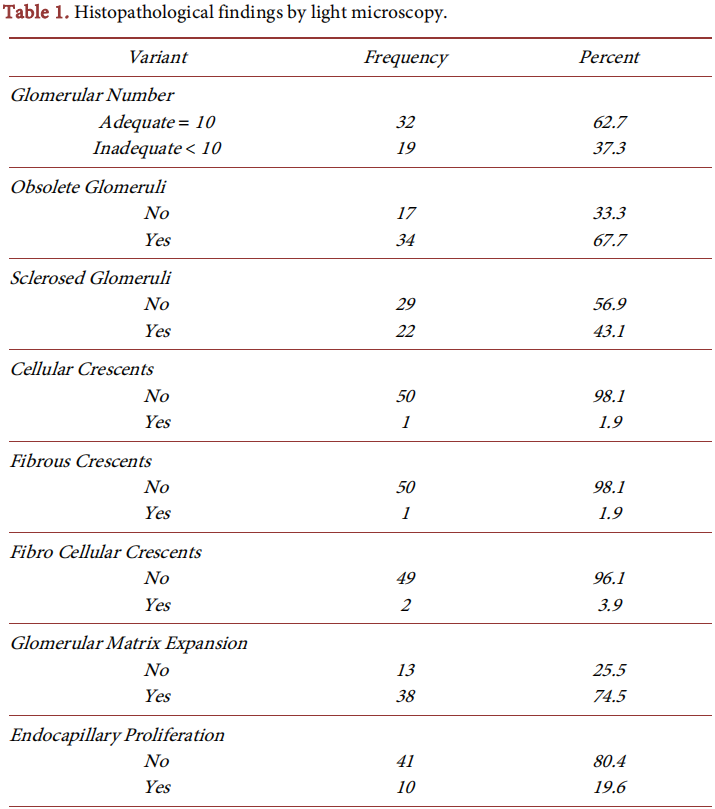
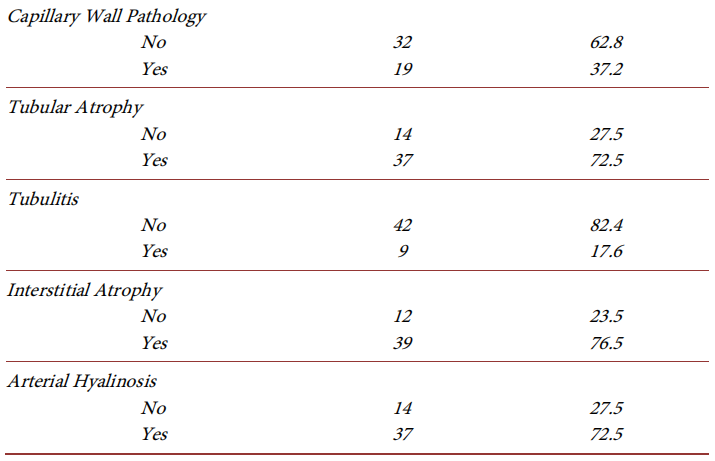
Immunofluorescence examination was available for 55 biopsies (88.7%). 52.5% of cases had some positive staining with IF, the most common being IgM in 40%, followed by IgG 26.7% and IgA in 13.3%. Full house stain was there in 10% same as for C3 stain. There was no light chain restriction by kappa and lambda in any of our biopsies. In all of the biopsies, light chain restriction by kappa and lambda were not detected.
Table 2 shows histopathological findings by EM. Foot process fusion was present in 97.4%, GBM thickening in 92.1% and mesangial expansion by matrix in 78.9%. Subendothelial deposit in 7.9%, Epithelial and subepithelial deposit in 15.8%.
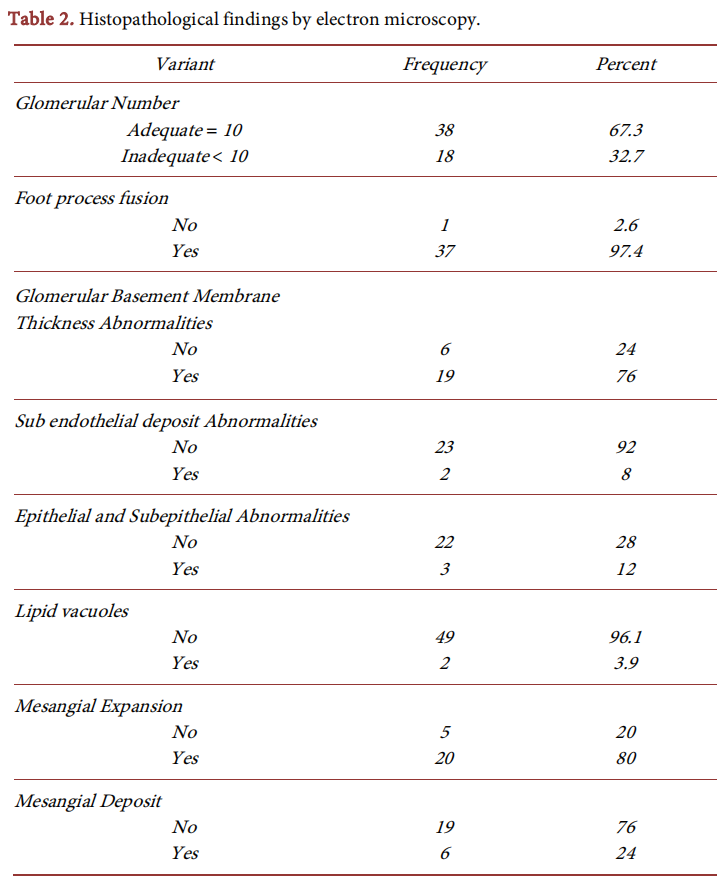
Based on light microscopy, immunofluorescence, and electron microscopy findings, 57.3% of patients had diabetic nephropathy only with no additional pathology, whereas 42.7% of patients had some form of NDKD, as shown in Table 3. The most common NDKD was focal segmental glomerulosclerosis in 20.7% of biopsies with primary FSGS being favored in 8.6% and secondary in 12.1%. Membranous nephropathy, Lupus nephritis and drug induced interstitial nephritis were each present in 3.7% of biopsies. 4.9% of patients had IgA nephropathy defined as dominant mesangial and/or capillary wall staining with IgA antibody Also, minimal change disease (MCD) was diagnosed in 2.4% of our biopsies. Lastly, diffuse proliferative glomerulonephritis (GN), ANCA associated GN and hypertensive nephropathy were each present in 1.2% of our biopsies.
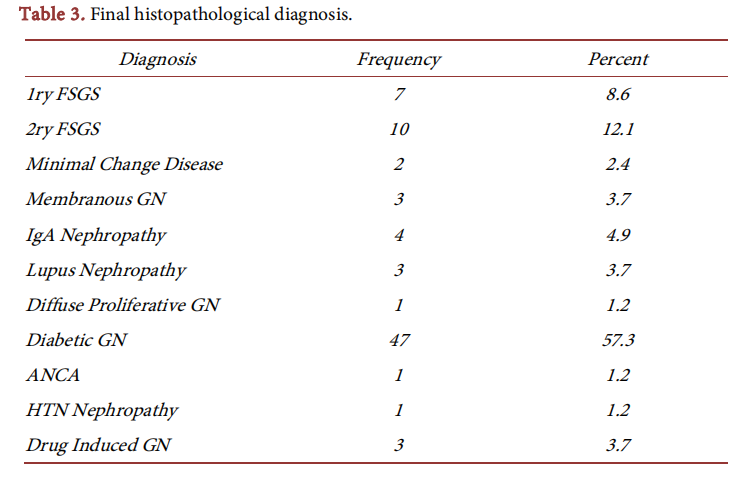
Table 4 shows the frequencies of clinical diagnostic impression, clinical suspected diabetic nephropathy 51.2%, FSGS 12.2 (primary 4.9 and secondary 7.3), membranous GN 3.7, minimal change GN 2.4%, while lupus GN, diffuse proliferative GN, ANCA and drug induced nephritis represent 1.2% for each. 14.7% had no definite clinical diagnostic impression.
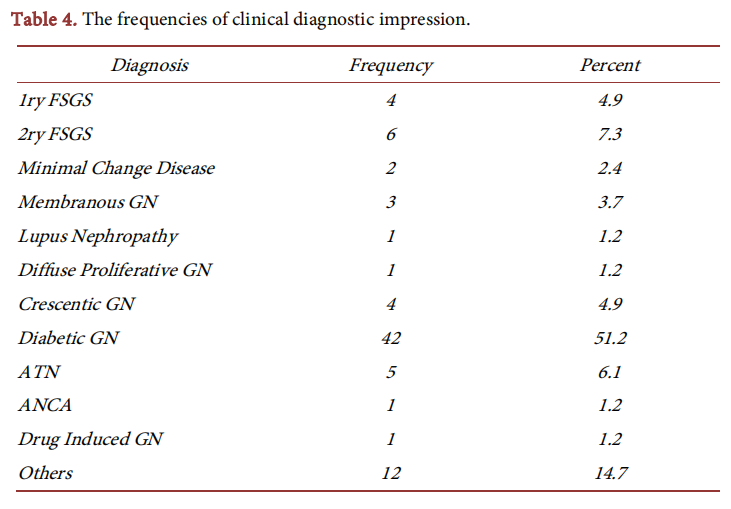
There were a few diagnoses with statistically significant difference between clinical diagnostic impression before biopsy and final pathological diagnosis. Table 5 shows the frequencies of clinical diagnostic impression/histopathology diagnosis. FSGS, primary and secondary, were underestimated by the clinicians being suspected in 4.9% and 7.3% of cases whereas they were histo-pathologically identified in 8.6% and 12.1% of cases, respectively. Also, IgA nephropathy and membranous, 0% for each in clinical impression and 4.9% and 3.7% respectively as histological diagnosis, same as for drug inducing nephritis and Lupus nephritis, 1.2% for each in clinical estimation and 3.7% for each in final histopathological diagnosis. While crescentic GN was overestimated by clinical judgment compared to biopsy finding (4% vs. 0%). Same for ATN, was entertained clinically 6.1% but was not present in any of biopsies. (Figure 1)
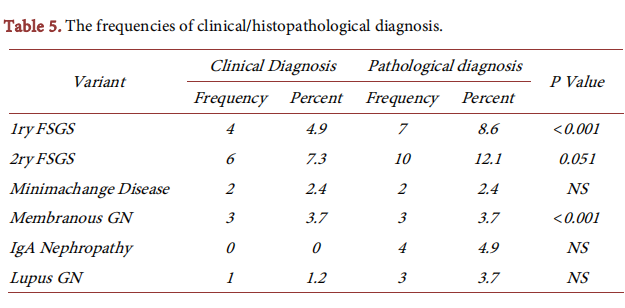
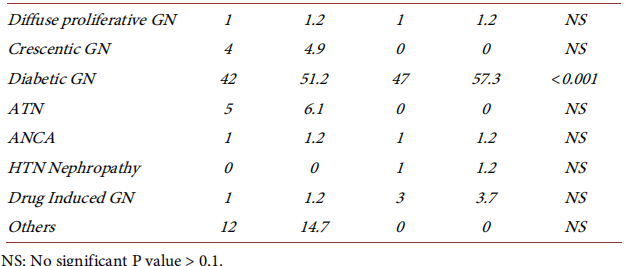
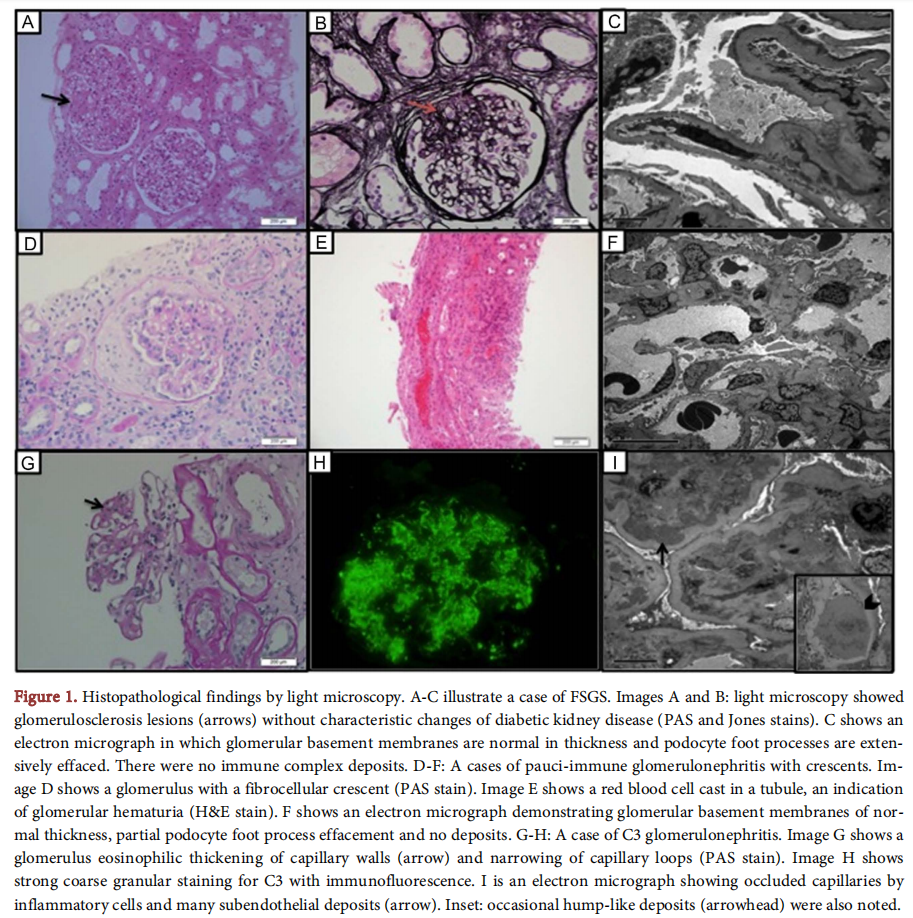
4. Discussion
Nondiabetic histological findings were very commonly present in diabetic patient who underwent kidney biopsy. The current study showed that 57.3% of all diabetic patients that underwent kidney biopsy had diabetic nephropathy histologically. Histopathological findings supporting the diagnosis of FSGS were present in 20.7%, IgA nephropathy present in 4.9%. Also, lupus nephritis, Membranous nephropathy, and drug induced interstitial nephritis and interstitial nephritis, induced by different drugs, were each present in 3.7% of the biopsies. MCD was present diagnosed in 2.4% of the biopsies. Lastly diffuse proliferative GN, ANCA associated GN and hypertensive nephropathy were each present in 1.2% of the biopsies.
Diabetic nephropathy (DN) is the leading cause of ESKD world-wide all over the world, diabetic nephropathy is the leading cause of end stage renal disease [19]. Projections from the recent Indian Council of Medical Research-India Diabetes study have shown that India has 62.4 million people with DM making diabetic nephropathy a leading cause of chronic kidney disease [20]. Studies from India and rest of Asia showed high prevalence of diabetic nephropathy as a leading cause of chronic kidney disease [20] [21]. The progressive rise in the number of patients with ESKD due to DN is a major social and economic problem in several countries. Furthermore, prognosis in such patients is poor compared to patients with ESKD due to other kidney diseases and hence special treatment guidelines are defined for such patients with diabetic nephropathy induced ESKD [21]. Proteinuria in DM patients is usually interpreted as a clinical manifestation of DN [22]. While the kidney biopsy is considered as the standard of care for evaluating proteinuria among our patients, it is uncommonly performed in people with diabetes mellitus and isolated proteinuria [23] and the primary aim of the kidney biopsy in proteinuric patients with DM is to confirm and or exclude non diabetic kidney disease (NDKD).
Worldwide, DN is the leading cause of ESKD, with a reported frequency of 10% - 15% in T2DM patients, however there is a great discrepancy between countries. Researchers studied diabetic patients using retrospective design and found that NDKD were present in between 7% - 44% in accordance with patient selection criteria [24] [25]. Different studies reported 22% as a prevalence of non-diabetic kidney diseases. A study from Asia showed that about 26.7% of diabetic biopsied patients had findings rather than diabetic nephropathy [26]. European study from Denmark reported it as 3% [15], whereas another study from Italy reported it to occur in 12% [27].
In Oman, health system is excellent and had been highly appraised by the World Health Organization [28] [29]. The health care is entirely free, yet certain procedures are not done as expected by the caring clinicians and as such the rate of biopsy is low. The indications for kidney biopsy in diabetic patients with CKD are recently diagnosed DM within <3 months in patients with CKD (46.2%), proteinuria with lack of diabetic retinopathy (31.4%), microscopic hematuria (64.9%) and positive immunological findings like high IgA, low C3/C4; positive ANA and ANCA. In diabetic patients with CKD, there are well known indications for doing native kidney biopsy, as in case of finding of microscopic hematuria (64.9%), recent diagnosis of DM within <3 months in patients with CKD (46.2%), presence of proteinuria with no findings suggestive of diabetic retinopathy (31.4%) and positive immunological findings like positive ANA, positive ANCA, high IgA and low C3/C4.
A study by Zukowaska E. and Tomaszewski M. revealed that indications of biopsies in diabetic patients with CKD were: Unexplained rapidly increasing proteinuria (67.5%), presence of nephrotic range proteinuria (58.7%), Proteinuria with rising serum creatinine (19.7%), Active urine sediments (17.4%), Active urine sediment and rising serum creatinine (8.7%) and unexpected serum creatinine (2.2%) [30].
Adequate glomerular number is important for proper pathological diagnosis. In our study an adequate glomerular sample was present in 64.6% of tissue submitted for LM. 88.7% and 76.8% of tissue submitted for both IF and EM, respectively.
An increase in glomerular basement membrane thickness leads to hematuria in 33% of patients with typical diabetic glomerulosclerosis [31], in our study GBM thickening was detected in 92% of all biopsies. While fusion of foot process was found in 97.4% of all biopsies.
According to the new classification of glomerular lesions in DN, the degree from light to severe are presented as follows [32]:
I) Minor or nonspecific (mild) light microscopy alterations and electron microscopy-proven glomerular basement membrane thickening.
IIa) Mild Mesangial expansion.
IIb) Severe Mesangial expansion.
III) Nodular sclerosis (Kimmelstiel-Wilson lesion).
IV) Advanced diabetic glomerulosclerosis
In this study, most patients’ glomerular lesions in DN were I, IIa or IIb. This reflects the clinical status of early diabetic patients being biopsied because of NDKD clinical features presentations, whereas diabetic patients with advanced disease were hardly biopsied and hence later stages were not found among our biopsy series.
By IF examination, 52.5% of all biopsies showed positive staining, indicating other findings rather than Diabetic Nephropathy. IgM positive stain was detected in 12 biopsies (40%), IgG in 8 biopsies (26.7%), while IgA positive stain was found in 4 biopsies (13.3%), while C3 was there in 3 biopsies (10%). There was a mixture of positive staining in numerous biopsies, however, pattern and intensity of staining were the dependable factors to establish the diagnosis.
In the present study, the histopathological findings supporting diabetic nephropathy were present in (57.3%) of all biopsies, while pathological findings other than diabetic nephropathy were present in 42.7% mainly with FSGS in (20.7%), IgA nephropathy in 4.9%. lupus, membranous GN and drug induced nephritis 3.75 for each. A study from Pakistan by Muhammad Arif et al. [33], revealed that minimal change disease (MCD) and/or focal segmental glomerulosclerosis (FSGS) were the most common NDKD. In USA, FSGS (21%) was reported as the most common lesion in patients with type-II diabetes followed by MCD (15.3%) [34]. Ghani AA et al. [35], a study from Saudi Arabia, revealed that NDKD was detected in 45.8% of biopsies of diabetic patients. In concordance with previous studies, the prevalence of NDKD ranges from 45% to 57% [33] [34] [35] [36] [37]. A nice study from Thailand [38], by Kittrawee Kritmetapak et al., found that almost half of patients with T2DM who went for kidney-biopsy, had NDKD, either isolated or superimposed on background of diabetic nephropathy. Mak et al , found that AIN was the highly common NDKD in about 50% of cases of Thai diabetic patients, followed by membranous nephropathy and IgA nephropathy [15]. Another an Indian study found AIN to be the most common NDKD, found in 18% of the patients with mixed renal disease (NDKD superimposed on DN), while membranous nephropathy (19.2%) was the most frequent diagnosis in patients with isolated NDKD [39]. However, Far east countries, Japan, China and Korea with type II DM who underwent kidney biopsy, IgA nephropathy was reported to be the most frequent type of NDKD [38] [39] [40] [41] [42]. Keeping in mind that IgA nephropathy is the most common primary glomerulonephritis in the general population of these countries, with a prevalence of 28.3% to 50.6% [43].
In our study, the comparison between clinical impression before doing the biopsy and the final histopathological diagnosis showed that the clinical impression of DN in 51.2% of cases was increased in the final pathological diagnosis to 57.3%. On the other hand, the clinical impression of NDKD was entertained in 48.8%, but it was decreased to 42.7% based on biopsy findings. The clinical impression of FSGS 12.2% (4.9% presumed primary and 7.3% presumed secondary) increased to 20.7% (8.6% primary and 12.1% secondary). IgA nephropathy was not the primary suspicion in any of the cases but was in the final diagnosis in 4.9%. Similarly, lupus nephritis and drug induced GN, were suspected clinically in 1.2% of cases and this increased to 3.7% for each in the final diagnosis.
While in the case of MCD the clinical impression and the final pathological diagnosis were similar 2.4%. Also, for membranous nephropathy the clinical and final pathological diagnosis were same 3.7%, same as for diffuse proliferative GN and ANCA 1.2% for each for both clinical impression and final histopathological diagnosis. However, there was a striking difference between the clinical impression and the final histopathological diagnosis in the case of ATN and crescentic GN, which were suspected clinically in 6.1% and 4.9% of biopsies, respectively but were not in the final histopathological diagnosis.
In the present study, the high prevalence of NDKD (42.7%) supports the current demand for further consideration to kidney-biopsy of patients with diabetes, presenting with the criteria stated above, as the finding of NDKD requires a different therapeutic approach (other than or in addition to conventional angiotensin-converting enzyme inhibitors or angiotensin receptor blockers) as steroids and other immunosuppressive medications. Innovative medicinal-agents for the treatment of diabetic nephropathy have recently been characterized. Endothelin receptor antagonists and agents targeting inflammation/fibrosis are probably the most promising candidates on top of the classical RAAS blockers [44] [45]. Hence, it is necessary that diabetic-patients with diabetic kidney disease are effectively categorized, distinguishing evidently those with diabetic nephropathy and those with NDKD. In addition, among those with DN, a reliable classification within different pathological categories [46] [47] will be of great value to individualize treatment strategies.
5. Conclusions
The present findings show that NDKDs are very common clinical condition in type-2 DM patients. The differential diagnosis of DNs and NDKDs is of considerable importance because of their management approach and prognosis.
Among diabetic’ patients, diabetic nephropathy was present in (57.3%) of all biopsies, while pathological findings other than diabetic nephropathy were present in 42.7% mainly with FSGS 20.7%, IgA nephropathy 4.9%. Membranous, lupus and drug induced nephropathy, 3.7% for each.
Therefore, and for better management strategies aiming for delaying the prognosis towards ESRD and to delay the requirement of life dependable renal replacement therapy, it is a great need to consider biopsy in diabetic patients when clinically and experimentally indicated.
Compliance with Ethical Standards Disclosure of Potential Conflicts of Interest
The study was approved by the Scientific Research Committee at the Royal Hospital and SQUH, Muscat, Oman and certify that the study was performed in accordance with the ethical standards as laid down in the 1964 Declaration of Helsinki and its later amendments ethical standards
Informed Consent
Each participant was freely given, informed consent to undergo biopsy and laboratory investigations.
Availability of Data and Material
Data of this paper is not available publicly but can be requested from the corresponding author in a reasonable time.
Funding
No funding available for both authors.
Acknowledgements
We would like to thank our patients and all the staff responsible for the delivery of patients’ care.
Contributorship Statement
https://mohcsr.gov.om/my-researches/.
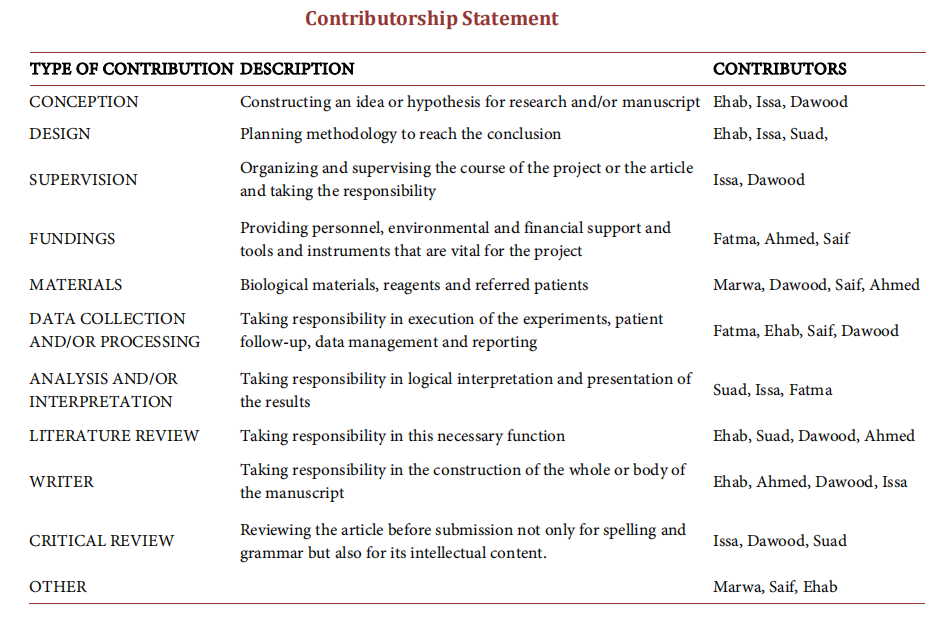
Conflicts of Interest
Authors declare no conflict of interest.
References
[1] Al Alawi, I., Al Salmi, I., Al Mawali, A., Al Maimani, Y. and Sayer, J.A. (2017) End-Stage Kidney Failure in Oman: An Analysis of Registry Data with an Emphasis on Congenital and Inherited Renal Diseases. International Journal of Nephrology, 2017, Article ID: 6403985. https://doi.org/10.1155/2017/6403985
[2] Al Ismaili, F., Al Salmi, I., Al Maimani, Y., Metry, A.M., Al Marhoobi, H., Hola, A., et al. (2017) Epidemiological Transition of End-Stage Kidney Disease in Oman. Kidney International Reports, 2, 27-35. https://doi.org/10.1016/j.ekir.2016.09.001
[3] Al Majarfi, A., Al Salmi, I., Metry, A.M., Al Ismaili, F., Hola, A. and Suad, H. (2018) Epidemiology of Patients at Initial Treatment with Hemodialysis. ARC Journal of Nephrology, 3, 6-12.
[4] Al Alawi, I., Al Salmi, I., Al Mawali, I. and Sayer, J.A. (2017) Kidney Disease in Oman: A View of the Current and Future Landscapes. Iranian Journal of Kidney Diseases, 11, 263-270. https://doi.org/10.1155/2017/6403985
[5] Alshaaili, K., Al Salmi, I., Metry, A.L.M., Al Ismail, F., Hola, A. and Saud, H. (2018) The Epidemiology of Hemolytic Uremic Syndrome: Clinical Presentation, Laboratory Findings, Management and Outcomes. International Journal of Hematology and Blood Disorders, 3, 1-6. https://doi.org/10.15226/ijhbd/3/1/00119
[6] Wild, S., Roglic, G., Green, A., Sicree, R. and King, H. (2004) Global Prevalence of Diabetes: Estimates for the Year 2000 and Projections for 2030. Diabetes Care, 27, 1047-1053. https://doi.org/10.2337/diacare.27.5.1047
[7] Boyle, J.P., Honeycutt, A.A., Narayan, K.M., Hoerger, T.J., Geiss, L.S., Chen, H., et al. (2001) Projection of Diabetes Burden through 2050: Impact of Changing Demography and Disease Prevalence in the U.S. Diabetes Care, 24, 1936-1940. https://doi.org/10.2337/diacare.24.11.1936
[8] Bethesda, M. (2015) US Renal Data System: USRDS 2015 Annual Data Report. The National Institute of Diabetes and Digestive and Kidney Diseases, Bethesda. [Cited 2020 September 17]. https://www.usrds.org/2015/view/Default.aspx
[9] Al-Lawati, J.A. (2017) Diabetes Mellitus: A Local and Global Public Health Emergency. Oman Medical Journal, 32, 177-179. https://doi.org/10.2337/diacare.24.11.1936
[10] Gambara, G., Remuzzi, M.G. and Bertani, T. (1993) Heterogeneous Nature of Renal Lesions in Type II Diabetes. Journal of the American Society of Nephrology, 3, 1458-1466. https://doi.org/10.1681/ASN.V381458
[11] Wong, T.Y., Choi, P.C., Szeto, C.C., To, K.F., Tang, N.L., Chan, A.W., Li, P.K. and Lai, F.M. (2002) Renal Outcome in Type 2 Diabetic Patients with or without Coexisting Nondiabetic Nephropathies. Diabetes Care, 25, 900-905. https://doi.org/10.2337/diacare.25.5.900
[12] Kim, B.S., Chang, Y.K., Song, H.C., Lee, S.Y., Jang, S.N., Kim, H.W., Shin, Y.S., Choi, Y.J., Jin, D.C. and Kim, Y.S. (2009) The Clinical Differentiations between Diabetic Nephropathy and Non-Diabetic Renal Disease in Type 2 Diabetic Patients. Korean Journal of Nephrology, 28, 588-594.
[13] Olsen, S. (1999) Identification of Non-Diabetic Glomerular Disease in Renal Biopsies from Diabetics—A Dilemma. Nephrology Dialysis Transplantation, 14, 1846-1849. https://doi.org/10.1093/ndt/14.8.1846
[14] Amoah, E., Glickman, J.L., Malchoff, C.D., Sturgill, B.C., Kaiser, D.L. and Bolton, W.K. (1988) Clinical Identification of Nondiabetic Renal Disease in Diabetic Patients with Type I and Type II Disease Presenting with Renal Dysfunction. American Journal of Nephrology, 8, 204-211. https://doi.org/10.1159/000167584
[15] Mak, S.K., Gwi, E., Chan, K.W., Wong, P.N., Lo, K.Y., et al. (1997) Clinical Predictors of Non-Diabetic Renal Disease in Patients with Non-Insulin Dependent Diabetes Mellitus. Nephrology Dialysis Transplantation, 12, 2588-2591. https://doi.org/10.1093/ndt/12.12.2588
[16] Kveder, R., Kajtna-Koselj, M., Rott, T. and Bren, A.F. (2001) Nephrotic Syndrome in Patients with Diabetes Mellitus Is Not Always Associated with Diabetic Nephropathy. Nephrology Dialysis Transplantation, 16, 86-87. https://doi.org/10.1093/ndt/16.suppl_6.86
[17] Serra, A., Romero, R., Bayes, B., Lopez, D. and Bonet, J. (2002) Is There a Need for Changes in Renal Biopsy Criteria in Proteinuria in Type 2 Diabetes? Diabetes Research and Clinical Practice, 58, 149-153. https://doi.org/10.1016/S0168-8227(02)00131-6
[18] Heine, G.H., Sester, U., Girndt, M. and Kohler, H. (2004) Acanthocytes in the Urine: Useful Tool to Differentiate Diabetic Nephropathy from Glomerulonephritis? Diabetes Care, 27, 190-194. https://doi.org/10.2337/diacare.27.1.190
[19] Parving, H.H., Mauer, M., Fioretto, P., Rossing, P., Ritz, E., Taal, M.W., Chertow, G.M., Marsden, P.A., Skorecki, K., Yu, A.S.L. and Barry, M. (2011) Diabetic Nephropathy. In Brenner and Rector’s the Kidney, 9th Edition, Saunders, Philadelphia, 1411-1444.
[20] Anjana, R.M., Pradeepa, R., Deepa, M., Datta, M., Sudha, V., Unnikrishnan, R., et al. (2011) Prevalence of Diabetes and Prediabetes (Impaired Fasting Glucose and/or Impaired Glucose Tolerance) in Urban and Rural India: Phase I Results of the Indian Council of Medical Research—INdia DIABetes (ICMR-INDIAB) Study. Diabetologia, 54, 3022-3027. https://doi.org/10.1007/s00125-011-2291-5
[21] Ritz, E. and Zeng, X. (2011) Diabetic Nephropathy-Epidemiology in Asia and the Current State of Treatment. Indian Journal of Nephrology, 21, 75-84. https://doi.org/10.4103/0971-4065.82122
[22] Rajapurkar, M.M., John, G.T., Kirpalani, A.L., Abraham, G., Agarwal, S.K., Almeida, A.F., et al. (2012) What Do We Know about Chronic Kidney Disease in India: First Report of the Indian CKD Registry. BMC Nephrology, 13, Article No. 10. https://doi.org/10.1186/1471-2369-13-10
[23] American Diabetes Association (2000) Diabetic Nephropathy. Diabetes Care, 23, S69-S72.
[24] National Kidney Foundation (2012) KDOQI Clinical Practice Guideline for Diabetes and CKD: 2012 Update. American Journal of Kidney Diseases, 60, 850-886. https://doi.org/10.1053/j.ajkd.2012.07.005
[25] Olsen, S. and Mogensen, C.E. (1996) How Often Is NIDDM Complicated with Non-Diabetic Renal Disease? An Analysis of Renal Biopsies and the Literature. Diabetologia, 39, 1638-1645. https://doi.org/10.1007/s001250050628
[26] Richards, N.T., Greaves, I., Lee, S.J., Howie, A.J. and Michael, J. (1992) Increased Prevalence of Renal Biopsy Findings Other than Diabetic Glomerulopathy in Type II Diabetes Mellitus. Nephrology Dialysis Transplantation, 7, 397-399.
[27] John, G.T., Date, A., Korula, A., Jeyasselan, L., Shastry, J.C. and Jacob, C.K. (1994) Nondiabetic Renal Disease in Noninsulin-Dependent Diabetics in a South Indian Hospital. Nephron, 67, 441-443. https://doi.org/10.1159/000188019
[28] Al Salmi, I. and Hannawi, S. (2016) The World Health Report—Health Systems Empowering Citizens and Improving Performance. Research on Humanities and Social Sciences, 6, 6.
[29] Al Salmi, I. and Hannawi, S. (2018) Health Workforce in the Sultanate of Oman: Improving Performance and the Health System. Journal of Internal Medicine and Patient Care, 1, 6 p.
[30] Zukowaska-Szczechowska, E. and Tomaszewski, M. (2004) Renal Affection in Patients with Diabetes Mellitus Is Not Always Caused by Diabetic Nephropathy. Roczniki Akademii Medycznej w Bialymstoku, 49, 185-189.
[31] Brocco, E., Fioretto, P., Mauer, M., Saller, A., Carraro, A., Frigato, F., et al. (1997) Renal Structure and Function in Non-Insulin Dependent Diabetic Patients with Microalbuminuria. Kidney International Supplements, 63, S40-S44.
[32] Tone, A., Shikata, K., Matsuda, M., Usui, H., Okada, S., Ogawa, D., et al. (2005) Clinical Features on Non-Diabetic Renal Diseases in Patients with Type 2 Diabetes. Diabetes Research and Clinical Practice, 69, 237-242. https://doi.org/10.1016/j.diabres.2005.02.009
[33] Arif, M., et al. (2009) An Evaluation of Renal Biopsy in Type-II Diabetic Patients. Journal of the College of Physicians and Surgeons Pakistan, 19, 627-631.
[34] Pham, T.T., Sim, J.J., Kujubu, D.A., Liu, I.L. and Kumar, V.A. (2007) Prevalence of Non-Diabetic Renal Disease in Diabetic Patients. American Journal of Nephrology, 27, 322-328. https://doi.org/10.1159/000102598
[35] Ghani, A.A., Al Waheeb, S., Al Sahow, A. and Hussain, N. (2009) Renal Biopsy in Patients with Type 2 Diabetes Mellitus: Indications and Nature of the Lesions. Annals of Saudi Medicine, 29, 450-453. https://doi.org/10.4103/0256-4947.57167
[36] Huang, F., Yang, Q., Chen, L., Tang, S., Liu, W. and Yu, X. (2007) Renal Pathological Changes in Patients with Type 2 Diabetes Are Not Always Diabetic Nephropathy: A Report of 52 Cases. Clinical Nephrology, 67, 293-297. https://doi.org/10.5414/CNP67293
[37] Waldherr, R., Ilkenhans, C. and Ritz, E. (1992) How Frequent Is Glomerulonephritis in Diabetes Mellitus Type II? Clinical Nephrology, 37, 271-273.
[38] Kritmetapak, K., Anutrakulchai, S., Pongchaiyakul, C. and Puapairoj, A. (2017) Clinical and Pathological Characteristics of Non-Diabetic Renal Disease in Type 2 Diabetes Patients. Clinical Kidney Journal, 11, 342-347. https://doi.org/10.1093/ckj/sfx111
[39] Kasinath, B.S., Mujais, S.K., Spargo, B.H. and Katz, A.I. (1983) Nondiabetic Renal Disease in Patients with Diabetes Mellitus. The American Journal of Medicine, 75, 613-617. https://doi.org/10.1016/0002-9343(83)90442-4
[40] Soni, S.S., Gowrishankar, S., Kishan, A.G. and Raman, A. (2006) Non Diabetic Renal Disease in Type 2 Diabetes Mellitus. Nephrology, 11, 533-537. https://doi.org/10.1111/j.1440-1797.2006.00681.x
[41] Matias, P., Viana, H., Carvalho, F. and Santos, J.R. (2009) Diabetes Mellitus and Renal Disease: When to Perform a Renal Biopsy? Portuguese Journal of Neprhology Hypertension, 23, 167-173.
[42] Mou, S., Wang, Q., Liu, J., Che, X., Zhang, M., Cao, L., et al. (2010) Prevalence of Non-Diabetic Renal Disease in Patients with Type 2 Diabetes. Diabetes Research and Clinical Practice, 87, 354-359. https://doi.org/10.1016/j.diabres.2009.11.012
[43] Lin, Y.L., Peng, S.J., Ferng, S.H., Tzen, C.Y. and Yang, C.S. (2009) Clinical Indicators Which Necessitate Renal Biopsy in Type 2 Diabetes Mellitus Patients with Renal Disease. International Journal of Clinical Practice, 63, 1167-1176. https://doi.org/10.1111/j.1742-1241.2008.01753.x
[44] Lytvyn, Y., Bjornstad, P., Pun, N., et al. (2016) New and Old Agents in the Management of Diabetic Nephropathy. Current Opinion in Nephrology and Hypertension, 25, 232-239. https://doi.org/10.1097/MNH.0000000000000214
[45] Anguiano, L., Riera, M., Pascual, J., et al. (2015) Endothelin Blockade in Diabetic Kidney Disease. Journal of Clinical Medicine, 4, 1171-1192. https://doi.org/10.3390/jcm4061171
[46] Fioretto, P. and Mauer, M. (2007) Histopathology of Diabetic Nephropathy. Seminars in Nephrology, 27, 195-207. https://doi.org/10.1016/j.semnephrol.2007.01.012
[47] Taervert, T.W.C., Mooyaart, A.L., Amann, K., et al. (2010) Pathologic Classification of Diabetic Nephropathy. Journal of the American Society of Nephrology, 21, 556-563. https://doi.org/10.1681/ASN.2010010010
This article is excerpted from the Open Journal of Nephrology by Wound World.
